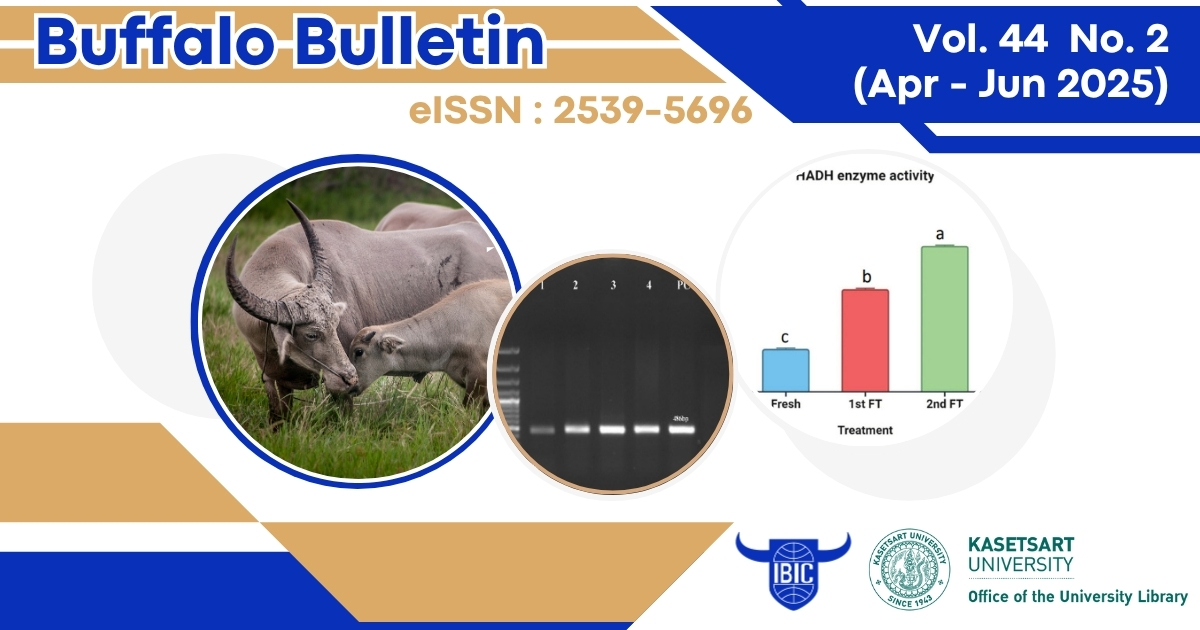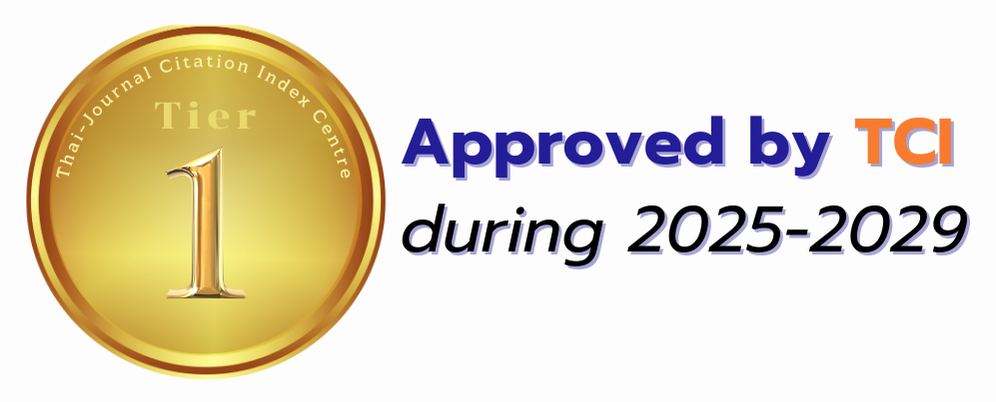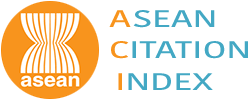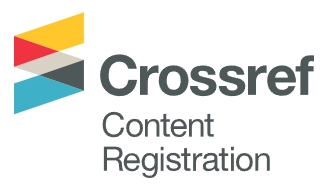ASSOCIATION BETWEEN SNP MARKERS AND MILK PRODUCTION TRAIT OF SWAMP BUFFALO
DOI:
https://doi.org/10.56825/bufbu.2025.4424280Keywords:
Bubalus bubalis, buffaloes , snp marker, milk , swamp buffalo , genotypeAbstract
The research of association between SNP markers and milk production trait of swamp buffalo was conducted to identify polymorphisms of SNP markers associated with milk/day trait of swamp buffalo. Milk/day data and hair bud samples were collected from 28 second parity milking swamp buffalo at 2 to 3 months at farmer farm in Prachinburi province for DNA extraction. DNA samples were used for 40 SNP genotyping by Mass Array method. The results showed 10 polymorphism SNP and associated with milk/day trait of swamp buffalo (P<0.01). They were 3 groups: 1) associated hormones (2 Leptin), 2) energy balance (2 GHRL, 1 ARHGAP39 and 3 MC4R) and 3) immune system (1 BOLADQA1, 1 TFAP2D). The 2 SNPs of Leptin genes (from exon 2 and 3, AY495587.1), There were 2 genotypes of Leptin_2 SNP at G1072A mutation point (GG and GA). The average milk/day of GG and GA were 4.03+0.05 and 5.89+0.26 kg respectively (P<0.01). The mutation point of Leptin_5 was G3441A with 3 genotypes GG, GA and AA. The average milk/day of GG, GA and AA genotypes were 5.01+0.07, 4.83+0.10 and 4.95+0.19 kg respectively (P<0.01). The GHRL genes (EF583468.1) had 2 SNPs (GHRL_1 and GHRL_2). The GHRL_1 (A122G) had 3 genotypes. There were AA, AG and GG, with average milk/day 5.82+0.09, 3.94+0.13 and 5.02+0.07 kg respectively (P<0.01). There were 3 genotypes of GHRL_2 (T380C), TT, TC and CC. The average milk/day were 5.01+0.08, 4.38+0.13 and 5.45+0.08 kg, respectively (P<0.01). The BOLADQA1 (rs110525467, C-T) had 2 genotypes CC and TT. The average milk/day was 4.28+0.06 and 5.60+0.09 kg respectively (P<0.01). In consideration with the allele frequency, the Leptin_5 SNP (G3441A) was suitable to develop as MAS for milk/day trait. The SNP of GHRL_2(T380C) and BOLADQA1 (rs110525467) were moderate for MAS. However, 3 SNPs can be used as MAS for selection and breeding and introducing new genetics from outside herd for milk/day trait development of swamp buffalo in this farm.
Downloads
Metrics
References
Al-Waith, H.K., N.N.AL-Anbari and T.R. Mohamed. 2018. Relationship of the DQA1 gen polymorphism with productive performance in Holstein cattle. Plant Arch., 18(2): 2636-2640. Available on: https://www.plantarchives.org/18-02/2636-2640%20(4515).pdf
Ahmad, S., I. Gaucher, F. Rousseau, E. Beaucher, M. Piot, J.F. Grongnet and F. Gaucheron. 2008. Effects of acidification on physico-chemical characteristics of buffalo milk: A comparison with cow’s milk. Food Chem., 106(1): 11-17. DOI: 10.1016/j.foodchem.2007.04.021
Barb, C.R., A.S. Robertson, J.B. Barrett, R.R. Kraeling and K.L. Houseknecht. 2004. The role of melanocortin-3 and -4 receptor in regulating appetite, energy homeostasis and neuroendocrine function in the pig. J. Endocrinol., 181(1): 39-52. DOI: 10.1677/joe.0.1810039
Block, S.S., W.R. Butler, R.A. Ehrhardt, A.W. Bell, M.E. Van Amburgh and Y.R. Boisclair. 2001. Decreased concentration of plasma leptin in periparturient dairy cows is caused by negative energy balance. J. Endocrinol., 171(2): 339-348. DOI: 10.1677/joe.0.1710339
Braz, C.U., G.M.F. Camargo, D.F. Cardoso, F.M.M. Gil, P.D.S. Fonseca, J.N.S.G. Cyrillo, M.E.Z. Mercadante, H.N. Oliveira and H. Tonhati. 2015. Polymorphisms in the GHRL gene and their associations with traits of economic interest in beef cattle. Genet. Mol. Res., 14(4): 18188-18197. Available on: https://www.geneticsmr.org/articles/polymorphisms-in-the-ghrl-gene-and-their-associations-with-traits-of-economic-interest-in-beef-cattle.pdf
Buchanan, F.C., C.J. Fitzsimmons, A.G. Van Kessel, T.D. Thue, D.C. Winkelman-Sim and S.M. Schmutz. 2002. Association of a missense mutation in the bovine leptin gene with carcass fat content and leptin mRNA levels. Genet. Sel. Evol., 34(1): 105-116. DOI: 10.1186/1297-9686-34-1-105
Buitenhuis, B., L.L. Janss, N.A. Poulsen, L.B. Larsen, M.K. Larsen and P. Sorensen. 2014. Genome-wide association and biological pathway analysis for milk-fat composition in Danish Holstein and Danish Jersey cattle. BMC Genomics, 15(1): 1112. DOI: 10.1186/1471-2164-15-1112
Carignano, H.A., D.L. Roldan, M.J. Beribe, M.A. Raschia, A. Amadio, J.P. Nani, G. Gutierrez, I. Alvarez, K. Trono, M.A. Poli and M.M. Miretti. 2018. Genome-wide scan for commons SNPs affecting bovine leukemia virus infection level in dairy cattle. BMC Genomics, 19(1): 142. DOI: 10.1186/s12864-018-4523-2
Chebel, R.C., F. Susca and J.E.P. Santos. 2008. Leptin genotype is associated with lactation performance and health of holstein cows. J. Dairy Sci., 91(7): 2893-2900. DOI: 10.3168/jds.2007-0891
Deng, T.X., C.Y. Pang, M.Q. Liu, C. Zhang and X.W. Liang. 2016. Synonymous single nucleotide polymorphisms in the MC4R gene that are significantly associated with milk production traits in water buffaloes. Genet. Mol. Res., 15(2). DOI: 10.4238/gmr.15028153
Gil, F.M., G.M. De Camargo, F.R. De Souza and D.F. Cardoso. 2013. Polymorphisms in the ghrelin gene and their associations with milk yield and quality in water buffaloes. J. Dairy Sci., 96(5): 3326-3331. DOI: 10.3168/jds.2012-6362
Gong, D.W., S. Bi, R.E. Pratley and B.D. Weintraub. 1996. Genomic structure and promoter analysis of the human obese gene. J. Biol. Chem., 271(8): 3971-3974. DOI: 10.1074/jbc.271.8.3971
Goszczynski, D.E., M. Corbi-Botto, H.M. Durand, A. Rogberg-Munoz, S. Munilla, P. Peral-Garcia, R.J.C. Cantet and G. Giovambattista. 2018. Evidence of positive selection towards Zebuine haplotypes in the BoLA region of Brangus cattle. Animal, 12(2): 215-223. DOI: 10.1017/S1751731117001380
Hogan, M.C., M.D. Griffin, S. Rossetti, V.E. Torres, C.J. Ward and P.C. Harris. 2004. PKHDL1, a homolog of the autosomal recessive polycystic kidney disease gene, encodes a receptor with inducible T lymphocyte expression. Hum. Mol. Genet., 12(6): 685-698. DOI: 10.1093/hmg/ddg068
Huang, M., X. Gao, J.Y. Li, H.Y. Ren, J.B. Chen and S.Z. Xu. 2010. Polymorphisms in MC4R gene and correlations with economic traits in cattle. Mol. Biol. Rep., 37: 3941-3944. DOI: 10.1007/s11033-010-0051-0
Kadokawa, H., D. Blache, Y. Yamada and G.B. Martin. 2000. Relationships between changes in plasma concentrations of leptin before and after parturition and the timing of first post-partum ovulation in high-producing Holstein dairy cows. Reproduction, Fertility and Development, 12(7-8): 405-411. DOI: 10.1071/rd01001
Lagonigro, R., P. Wiener, F. Pilla, J.A. Woolliams and J.L. Williams. 2003. A new mutation in the coding region of the bovine leptin gene associated with feed intake. Anim. Genet. 34(5): 371-374. DOI: 10.1046/j.1365-2052.2003.01028.x
Liu, H., W. Tian, L. Zan, H. Wang and H. Cui. 2010. Mutations of MC4R gene and its association with economic traits in Qinchuan cattle. Mol. Biol. Rep., 37(1): 535-540. DOI: 10.1007/s11033-009-9706-0
Ma, S. and F.V. Nowak. 2011. The RhoGAP domain-containing protein, Porf-2, inhibits proliferation and enhances apoptosis in neural stem cells. Mol. Cell. Neurosci., 46(3): 573-582. DOI: 10.1016/j.mcn.2010.12.008
Magni, P., M. Motta and L. Martini. 2000. Leptin: A possible link between food intake, energy expenditure, and reproductive function. Regul. Peptides., 92(1-3): 51-56. DOI: 10.1016/s0167-0115(00)00149-x
Matteis, G.D., M.C. Scata, F. Grandoni, F. Petrera, F. Abeni, G. Catillo, F. Napolitano and B. Moioli. 2012. Association analyses of single nucleotide polymorphisms in the leptin and leptin receptor genes on milk and morphological traits in Holstein cows. J. Anim. Sci., 2(3): 174-182. DOI: 10.4236/ojas.2012.23024
Nayeri, S. and P. Stothard. 2016. Tissues, metabolic pathways and genes of key importance in lactating dairy cattle. Springer Science Reviews, 4(2): 49-77. DOI: 10.1007/s40362-016-0040-3
NRC. 2001. Subcommittee on Dairy Cattle Nutrition, Committee on Animal Nutrition, 7th ed. Board on Agriculture and Natural Resources, National Research Council, National Academy Press, Washington, D.C., USA.
Orru, L., G.M. Terzano, F. Napolitano, M.C. Savarese, G. De Matteis, M.C. Scata, G. Catillo and B. Moioli. 2007. DNA polymorphisms in River buffalo Leptin gene. Ital. J. Anim. Sci., 6(2): 342-344. DOI: /10.4081/ijas.2007.s2.342
Piorkowska, K., M. Tyra, M. Rogoz, K. Ropka-Molika, M. Oczkowicza and M. Rozycki. 2010. Association of the melanocortin-4 receptor (MC4R) with feed intake, growth, fatness and carcass composition in pigs raised in Poland. Meat Sci., 85(2): 297-301. DOI: 10.1016/j.meatsci.2010.01.017
Prajapati, G.N., A. Kumar, N.A. Laxmi, N.K. Singh and A.K. Mathur. 2018. Parallelism of Nesfatin-1, Ghrelin and Leptin with metabolic parameters and progesterone at puberty in Murrah buffalo Heifers. Journal of Animal Research, 8(1): 9-14. DOI: 10.30954/2277-940X.2018.00150.02
Razquin, C., A. Marti and J.A. Martinez. 2011. Evidences on three relevant obesogenes: MC4R, FTO and PPARγ . Approaches for personalized nutrition. Mol. Nutr. Food. Res., 55(1): 136-149. DOI: 10.1002/mnfr.201000445
Santos-Alvarez, J., R. Goberna and V.S. Nchez-Margalet. 1999. Human leptin stimulates proliferation and activation of human circulating monocytes. Cell. Immunol., 194(1): 6-11. DOI: 10.1006/cimm.1999.1490
Seeley, R.J., D.L. Drazen and D.J. Clegg. 2004. The critical role of the melanocortin system in the control of energy balance. Annu. Rev. Nutr., 24: 133-149. DOI: 10.1146/annurev.nutr.24.012003.132428
Song, X.M., J.F. Jiang, G.Z. Zhang, F.X. Shi and Y.Q. Jiang. 2012. DNA polymorphisms of the Hu sheep melanocortin-4 receptor gene associated with birth weight and 45-day weaning weight. Genet. Mol. Res., 11(4): 4432-4441. DOI: 10.4238/2012.September.27.3
Stone, R.T., S.M. Kappes and C. Beattie. 1996. The bovine homolog of the obese gene maps to chromosome 4. Mamm. Genome, 7(5): 399-400. DOI: 10.1007/s003359900119
Takeshima, S., A. Miki, M. Kado and Y. Aida. 2007. Establishment of a sequence‐based typing system for BoLA‐DQA1 exon 2. Tissue Antigens, 69(2): 189-199. DOI: 10.1111/j.1399-0039.2006.00751.x
Uniprot. 2021. UniProtKB - Q9C0H5 (RHG39_HUMAN). Available: https://www.uniprot.org/uniprot/Q9C0H5
Vallinoto, M., M.P.C. Schneider, A. Silva, L. Iannuzzi and B. Brenig. 2004. Molecular cloning and analysis of the swamp and river buffalo leptin gene. Anim. Genet., 35(6): 462-463. DOI: 10.1111/j.1365-2052.2004.01186.x
Van den Maagdenberg, K., A. Stinckens, E. Claeys, M. Seynaeve, A. Clinquart, M. Georges, N. Buysand and S. De Smet. 2007. The Asp298Asn missense mutation in the porcine melanocortin-4 receptor (MC4R) gene can be used to affect growth and carcass traits without an effect on meat quality. Animal, 8(1): 1089-1098. DOI: 10.1017/S1751731107000456
Yan, L.J., X.T. Fang, Y. Liu, C.L. Zhang, X.X. Liu, J. Zhao, J.J. Li and H. Chen. 2013. Effects of single and combined genotypes of MC4R and POU1F1 genes on two production traits in Langshan chicken. Mol. Biol. Rep., 40(7): 4645-4650. DOI: 10.1007/s11033-013-2558-7









.png)








